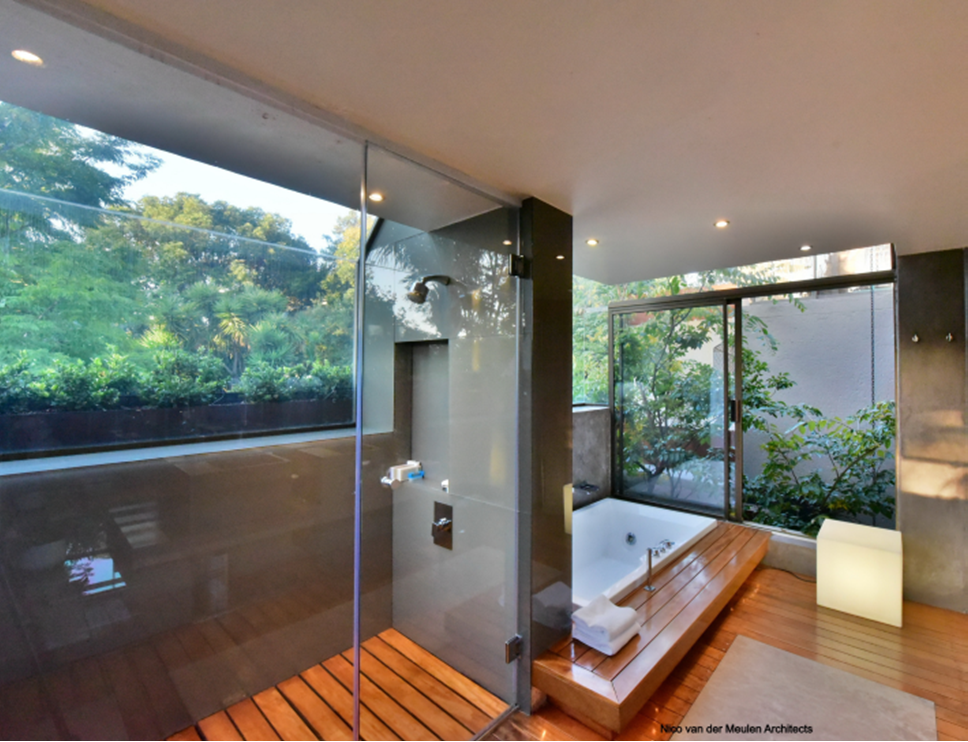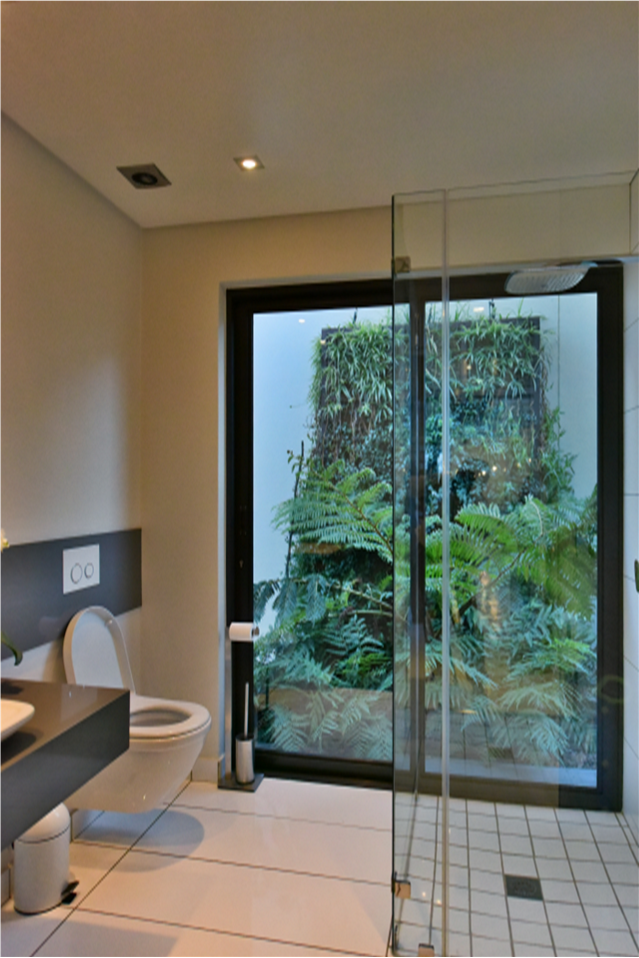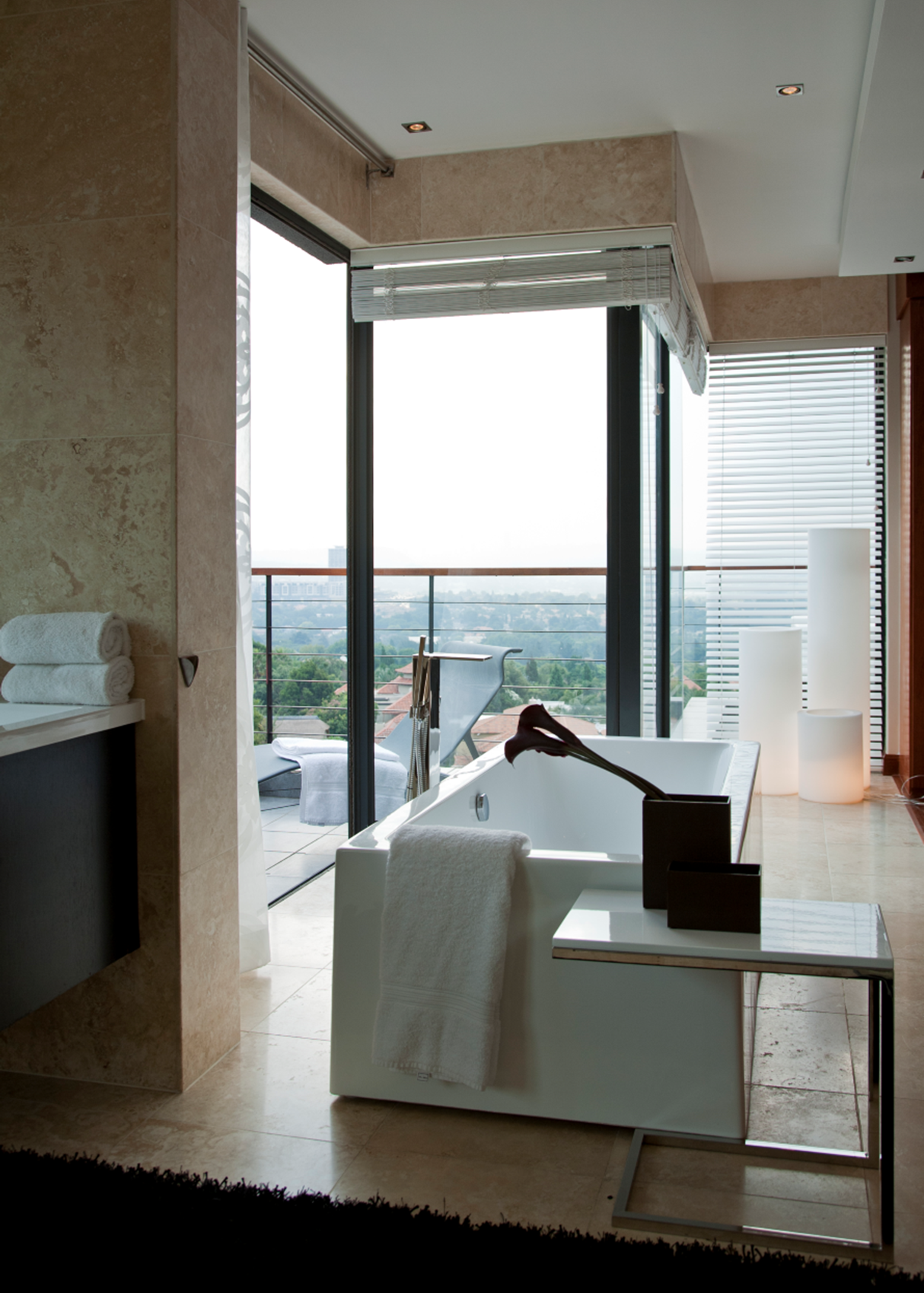
In this article I look more at the actual design of the bathroom, in another, I will discuss the bathroom fittings.
Preferably bathrooms should be designed with north-facing sliding doors next to north-facing bedrooms in the Southern Hemisphere, and where possible have east-facing windows in the bathroom to allow the morning sun in. The best is bathrooms open to the garden or a balcony for the ”back to nature” vibe, with large openings for ventilation, and outdoor showers for those balmy summer days. (Or for a bracing wake-up on a cool day)




Avoid south-facing bathrooms with tiny windows….” the dark hole of Calcutta” is the usual description for these bathrooms, driving anybody to desperation on a “Blue Monday” and instilling an association of depression with bathrooms.
Even for guest toilets, try to use full glass walls if the necessary privacy can be created. If the toilet is anywhere near the living spaces, which often happens in open-plan homes, use a powder room with a second door leading into the actual toilet space. Another “trick” is to hide the toilet door in some form of cladding if it is in the entrance hall.


In the bathroom, it is ideal to put the toilets in a separate glass enclosure, (acid-washed if required) with its own window for ventilation. And if it is the main bathroom, having a glazed shower wall to the bedroom appeals to many people. Remember privacy glass is also available to allow views only when desired. A double shower is a requisite in the main bathroom.
Try to put a window in every shower, to ventilate and prevent mould growing, and the odour of stagnant water.

A very important item is storage in bathrooms.  So often you see beautiful, minimalistic bathrooms, and then wonder how people live in them: Where do they put all the normal paraphernalia that is required in a bathroom? The electric toothbrush, toothpaste, extra soap (or even a soap dish), face cleansers, aftershave, etc., And what about the medicine cabinet?
So often you see beautiful, minimalistic bathrooms, and then wonder how people live in them: Where do they put all the normal paraphernalia that is required in a bathroom? The electric toothbrush, toothpaste, extra soap (or even a soap dish), face cleansers, aftershave, etc., And what about the medicine cabinet?
The same applies to the shower if there is not a niche or at least some glass shelves, where are the shampoos, conditioners, etc. stored? And for those who like to shave in the shower, a space is needed to put the razor and shaving cream, and a mirror is absolutely required.
Often there are these very expensive fittings in a shower, but no provision for storing the essentials, such as shampoos, conditioner or soap?
We also often install a steam generator at the main shower, so preferably there would be some form of a seat to use for relaxing in the steam. This also necessitates ensuring that there is somewhere to hide the steam generator and the necessary power supply is allowed for.

Storage is also required at a bath, and especially a freestanding bath. If no provision is made for somewhere to put down stuff, where are items such as a bottle of champagne, glasses, oysters, or strawberries going to stand? If it is a built-in bath, a niche behind it or an extended base works well, while with a freestanding bath some form of coffee table/ podium is required.
If a bubble bath/spa bath is chosen, remember either access to the pump, or if the pump is moved away, a hidden spot is needed to prevent an eyesore. (And do not forget a 25Amp connection to the pump!) With freestanding baths, it is important to allow enough space to move around the bath for cleaning.
Heating in a bathroom is essential to prevent running around shivering, and the only heating that works well in a bathroom is underfloor heating. Water-based systems are used in most of our contemporary houses, and as it can be combined with solar panels and heat pumps, it is more affordable than any other system to operate, though the installation is pricey.
In existing homes, it is recommended to install radiant based wall heaters, which even though it uses a lot of power only needs to be switched on while you are in the bathroom, as it heats only you and not the room. There is even a paint system available that can be applied to a wall to form a radiant heater.
If a water-based system is too expensive think about using normal electrical underfloor or wall heating, connected to a timer to switch it on a while before the bathroom is used, and switches off by the time the bathroom is occupied. (Except if a long time is spent in the bathroom, then the switch-off time should be slightly delayed.)

Floors in bathrooms used to be tiles only, but nowadays there are many options. If underfloor heating is used, some form of ceramic or sintered stone floor works well, as does epoxy floors or real stone. All these products are practical, conducts heat well, and are easy to clean and dry. With radiant heating, a treated timber deck floor works well, or else radiant panels inserted into the decking. We often use duckboards in showers, as it is warm underfoot and allows good drainage.

Walls in bathrooms underwent a transformation during the last decade. Gone are the shiny ceramic floor to ceiling tiles, often in garish colours or sterile white. Now back sprayed glass panels, large sintered tiles or natural stone panels, wood cladding, or Venetian plaster are used. In more rustic bathrooms even varnished stock bricks are used and spray-painted wood is popular in high-tech bathrooms
The layout of a bathroom is important as it determines the functionality of the bathroom.
An ample vanity, large windows or sliding doors, enough storage and open space to move, a shower of sufficient size with some shelving – these are the things that make a bathroom a joy to use.

Now for the technical part:
Sizing of pipes
Always insist on all the piping being at least 20mm, preferably 25 mm, leading to the geyser. It does not matter how high the pressure is, if the pipes are not big enough, the bath and shower will be water-starved if several faucets are open at the same time.
A 32mm ring supply around the building ensures even pressure and water flow everywhere.
Position of geysers:
In a big, luxury home geysers need to be placed in the closest possible position to the bathrooms. Preferably use an instant heater in the kitchen and guest toilet, otherwise, there will be a long wait for hot water. In a kitchen where little bits of hot water is often used, more water is wasted than actually used. If there is one big water heating installation, a water circulating pump should be considered. But it must be kept in mind that if the circuit is in the ceiling of the first or second floor, a lot of water will still be wasted before the hot water gets to the faucet being used on the ground floor.
 Type of geyser:
Type of geyser:
In terms of the National Building Regulations at least 50% of water heating must not be direct electrical heating. This means that either solar or a heat pump must be used. If it is solar, try to place solar panels close to the bathrooms/ kitchen, however, if it is a heat pump it gets more difficult as usual, it is more economical to use only one pump, which leads back to the discussion above.
Height of fittings:
The standard height of pedestal basins used to be around 800mm, but it could be a bit lower for children’s bathrooms and higher for main suites.
For wall-hung toilets, it is around 400-450mm, but most people prefer it to be positioned a bit lower than too high to avoid dangling feet. Both wall-hung toilets and bidets usually come with the manufacturer’s instructions recommending a height.
A standard height for built-in baths is around 400mm, while free-standing baths usually come with installation instructions.
We place the underside of shower mixers at 1m above the finished floor, and the shower rose should be at least 1,8m above the floor, or higher for tall people.


very impressive indeed
So luxious & contemporary !!!